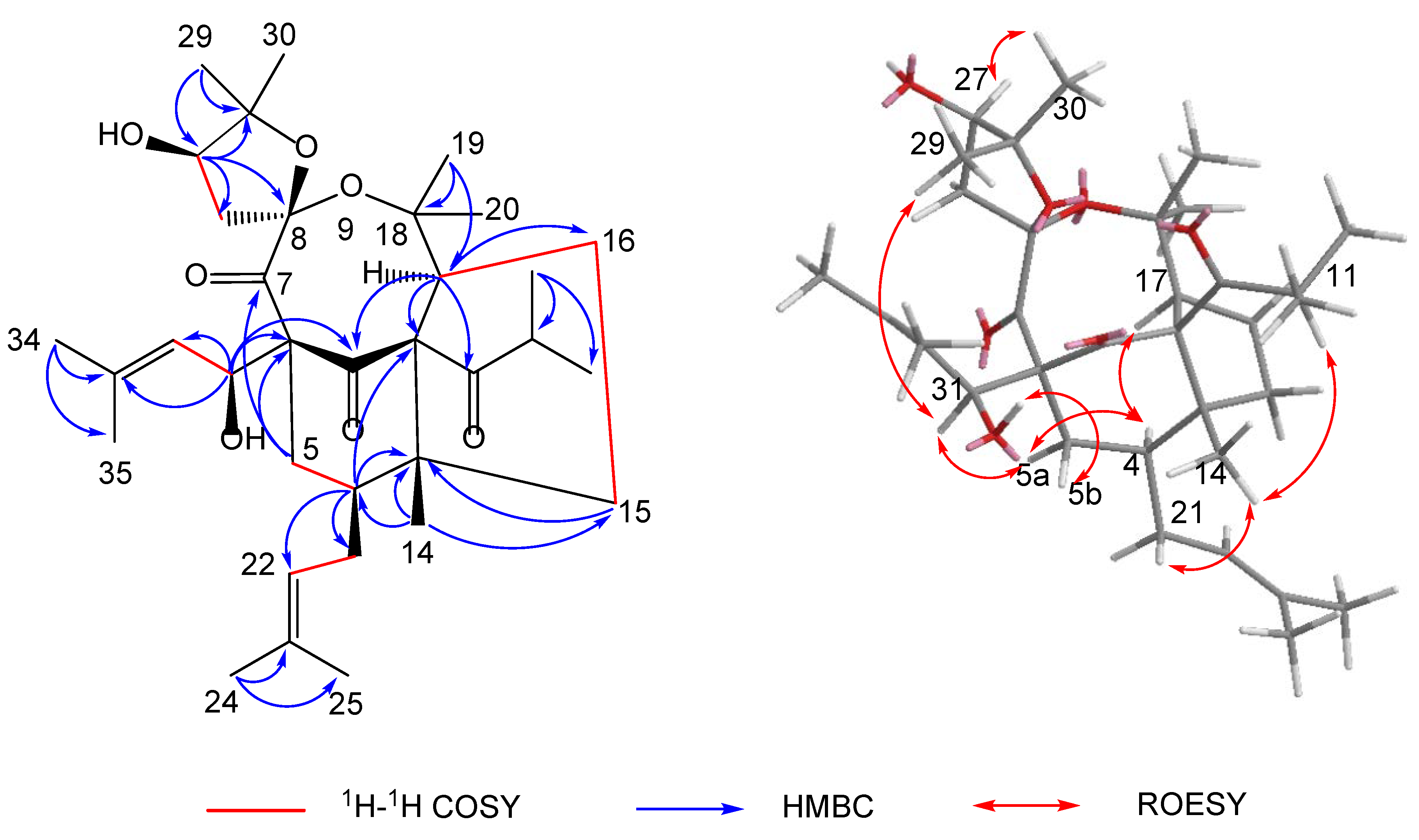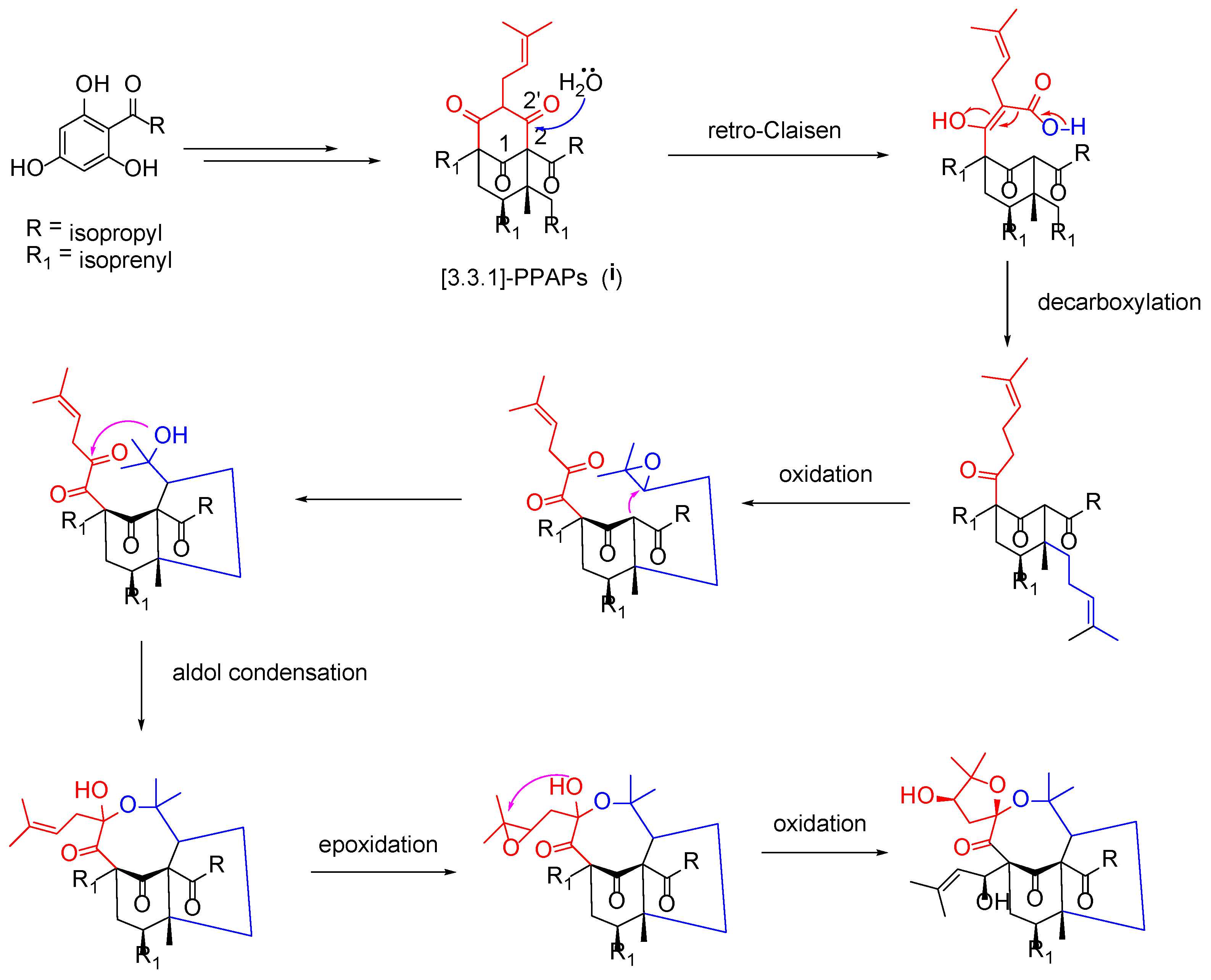Hyperacmosin R, a New Decarbonyl Prenylphloroglucinol with Unusual Spiroketal Subunit from Hypericum acmosepalum
Abstract
:1. Introduction
2. Results and Discussion
3. Materials and Methods
3.1. General Experimental Procedures
3.2. Plant Materials
3.3. Extraction and Isolation
3.4. Structural Elucidation
3.5. Hepatoprotection Bioassays (In Vitro)
4. Conclusions
Supplementary Materials
Author Contributions
Funding
Institutional Review Board Statement
Informed Consent Statement
Data Availability Statement
Conflicts of Interest
Sample Availability
References
- Yang, X.W.; Grossman, R.; Xu, G. Research progress of polycyclic polyprenylated acylphloroglucinols. Chem. Rev. 2018, 118, 3508–3558. [Google Scholar] [CrossRef] [PubMed]
- Zhang, L.J.; Chiou, C.T.; Cheng, J.J.; Huang, H.C.; Kuo, L.M.Y.; Liao, C.C.; Bastow, K.F.; Lee, K.H.; Kuo, Y.H. Cytotoxic polyisoprenyl benzophenonoids from Garcinia subelliptica. J. Nat. Prod. 2010, 73, 557–562. [Google Scholar] [CrossRef] [PubMed]
- Guo, Y.; Zhang, N.; Chen, C.M.; Huang, J.F.; Li, X.N.; Liu, J.J.; Zhu, H.C.; Tong, Q.Y.; Zhang, J.W.; Luo, Z.W.; et al. Tricyclic polyprenylated acylphloroglucinols from St John’s Wort, Hypericum perforatum. J. Nat. Prod. 2017, 80, 1493–1504. [Google Scholar] [CrossRef] [PubMed]
- Li, D.Y.; Xue, Y.B.; Zhu, H.C.; Li, Y.; Sun, B.; Liu, J.J.; Yao, G.M.; Zhang, J.W.; Du, G.; Zhang, Y.H. Hyperattenins A–I, bioactive polyprenylated acylphloroglucinols from Hypericum attenuatum Choisy. RSC Adv. 2015, 5, 5277–5287. [Google Scholar] [CrossRef]
- Le, D.H.; Nishimura, K.; Takenaka, Y.; Mizushina, Y.; Tanahashi, T. Polyprenylated benzoylphloroglucinols with DNA polymerase inhibitory activity from the fruits of Garcinia schomburgkiana. J. Nat. Prod. 2016, 79, 1798–1807. [Google Scholar] [CrossRef]
- Chen, J.J.; Ting, C.W.; Hwang, T.L.; Chen, I.S. Benzophenone derivatives from the fruits of Garcinia multiflora and their anti-inflammatory activity. J. Nat. Prod. 2009, 72, 253–258. [Google Scholar] [CrossRef]
- Zhang, J.S.; Zou, Y.H.; Guo, Y.Q.; Li, Z.Z.; Tang, G.H.; Yin, S. Polycyclic polyprenylated acylphloroglucinols: Natural phosphodiesterase-4 inhibitors from Hypericum sampsonii. RSC Adv. 2016, 6, 53469–53476. [Google Scholar] [CrossRef]
- Lee, J.Y.; Duke, R.K.; Tran, V.H.; Hook, J.M.; Duke, C.C. Hyperforin and its analogues inhibit CYP3A4 enzyme activity. Phytochemistry 2006, 67, 2550–2560. [Google Scholar] [CrossRef]
- Marti, G.; Eparvier, V.; Moretti, C.; Susplugas, S.; Prado, S.; Grellier, P.; Retailleau, P.; Gueritee, F.; Litaudon, M. Antiplasmodial benzophenones from the trunk latex of Moronobea coccinea (Clusiaceae). Phytochemistry 2009, 70, 75–85. [Google Scholar] [CrossRef]
- Zhu, H.C.; Chen, C.M.; Yang, J.; Li, X.N.; Liu, J.J.; Sun, B.; Huang, S.X.; Li, D.Y.; Yao, G.M.; Luo, Z.W.; et al. Bioactive acylphloroglucinols with adamantyl skeleton from Hypericum sampsonii. Org. Lett. 2014, 16, 6322–6325. [Google Scholar] [CrossRef]
- Li, Z.Q.; Luo, L.; Ma, G.Y.; Chen, X. Phloroglucinol and flavonoid constituents of Hypericum acmosepaium. J. Yunnan Univ. 2004, 26, 162–167. [Google Scholar]
- Wang, X.; Wang, J.J.; Suo, X.Y.; Sun, H.R.; Zhen, B.; Sun, H.; Li, J.G.; Ji, T.F. Hyperacmosins H–J, three new polycyclic polyprenylated acylphloroglucinol derivatives from Hypericum acmosepalum. J. Asian Nat. Prod. Res. 2020, 22, 521–530. [Google Scholar] [CrossRef] [PubMed]
- Wang, X.; Shi, M.J.; Wang, J.J.; Suo, X.Y.; Sun, H.R.; Zhen, B.; Sun, H.; Li, J.G.; Ji, T.F. Hyperacmosins E–G, three new homoadamantane-type polyprenylated acylphloroglucinols from Hypericum acmosepalum. Fitoterapia 2020, 142, 104535. [Google Scholar] [CrossRef] [PubMed]
- Suo, X.Y.; Shi, M.J.; Dang, J.; Yue, H.L.; Tao, Y.D.; Zhen, B.; Wang, J.J.; Wang, X.; Sun, H.R.; Sun, H.; et al. Two new polycyclic polyprenylated acylphloroglucinols derivatives from Hypericum acmosepalum. J. Asian Nat. Prod. Res. 2021, 23, 1068–1076. [Google Scholar] [CrossRef]
- Sun, M.X.; Dang, J.; Zhu, T.T.; Wang, X.; Suo, X.Y.; Wang, J.J.; Ji, T.F.; Liu, B. Hyperacmosin N, new acylphloroglucinol derivative with complicated caged core from Hypericum acmosepalum. Tetrahedron 2021, 94, 132286. [Google Scholar] [CrossRef]
- Sun, M.X.; Wang, X.; Zhu, T.T.; Suo, X.Y.; Wang, J.J.; Ji, T.F.; Liu, B. Hyperacmosins K–M, three new polycyclic polyprenylated acylphloroglucinols from Hypericum acmosepalum. RSC Adv. 2021, 11, 21029–21035. [Google Scholar] [CrossRef]
- Fukuyama, Y.; Minami, H.; Kuwayama, A. Garsubellins, polyisoprenylated phloroglucinol derivatives from Garcinia subelliptica. Phytochemistry 1998, 49, 853–857. [Google Scholar] [CrossRef]
- Hashida, C.; Tanaka, N.; Kashiwada, Y.; Ogawa, M.; Takaishi, Y. Prenylated phloroglucinol derivatives from Hypericum perforatum var. Angustifolium. Chem. Pharm. Bull. 2008, 56, 1164–1167. [Google Scholar] [CrossRef]
- Yang, J.B.; Liu, R.D.; Ren, J.; Wei, Q.; Wang, A.G.; Su, Y.L. Two new prenylated phloroglucinol derivatives from Hypericum scabrum. J. Asian Nat. Prod. Res. 2016, 18, 436–442. [Google Scholar] [CrossRef]
- Liu, X.; Yang, X.W.; Chen, C.Q.; Wu, C.Y.; Zhang, J.J.; Ma, J.Z.; Wang, H.; Yang, L.X.; Xu, G. Bioactive polyprenylated acylphloroglucinol derivatives from Hypericum cohaerens. J. Nat. Prod. 2013, 76, 1612–1618. [Google Scholar] [CrossRef]
- Ma, J.; Xia, G.Y.; Zang, Y.D.; Li, C.J.; Yang, J.B.; Huang, J.W.; Zhang, J.J.; Su, Y.L.; Wang, A.G.; Zhang, D.M. Three new decarbonyl prenylphloroglucinols bearing unusual spirost subunits from Hypericum scabrum and their neuronal activities. Chinese Chem. Lett. 2021, 32, 1173–1176. [Google Scholar] [CrossRef]





| No | 1 a | 2 b | ||
|---|---|---|---|---|
| δH (J in Hz) | δC, Type | δH (J in Hz) | δC, Type | |
| 1 | 206.2, C | 82.3, C | ||
| 2 | 78.8, C | 193.0, C | ||
| 3 | 58.2, C | 116.6, C | ||
| 4 | 1.98, brs | 39.3, CH | 173.0, C | |
| 5 | 2.45, m; 1.25, m | 36.3, CH2 | 59.7, C | |
| 6 | 67.1, C | 2.03, m; 1.49, m | 38.6, CH2 | |
| 7 | 202.5, C | 1.49, m | 42.5, CH | |
| 8 | 113.1, C | 46.6, C | ||
| 9 | 204.7, C | |||
| 10 | 218.7, C | 208.7, C | ||
| 11 | 2.90, m | 43.4, CH | 1.72, m | 48.9, CH |
| 12 | 1.07, d (6.4) | 20.5, CH3 | 1.08, d (6.4) | 16.7, CH3 |
| 13 | 1.41, d (6.4) | 23.8, CH3 | 1.27, m; 1.63, m | 27.6, CH2 |
| 14 | 0.88, s | 18.6, CH3 | 0.77, t (7.4) | 11.7, CH3 |
| 15 | 1.89, m; 1.34, m | 35.4, CH2 | 3.16, dd (14.4, 7.4) 3.02, dd (14.4, 7.4) | 22.3, CH2 |
| 16 | 2.10, m; 1.80, m | 27.5, CH2 | 5.06, t (7.4) | 121.3, CH |
| 17 | 3.04, brs | 54.7, CH | 132.6, C | |
| 18 | 85.4, C | 1.65, s | 25.8, CH3 | |
| 19 | 0.89, s | 23.8, CH3 | 1.71, s | 18.0, CH3 |
| 20 | 1.15, s | 26.5, CH3 | 1.77, dd (13.0, 5.6) 2.67, dd (13.0, 11.0) | 30.4, CH2 |
| 21 | 2.08, m; 1.70, m | 30.9, CH2 | 4.55, dd (11.0, 5.6) | 90.2, CH |
| 22 | 5.31, brs | 124.7, CH | 71.0, C | |
| 23 | 133.4, C | 1.39, s | 27.1, CH3 | |
| 24 | 1.62, s | 18.1, CH3 | 1.22, s | 24.2, CH3 |
| 25 | 1.78, s | 26.1, CH3 | 1.52, m; 2.16, m | 26.7, CH2 |
| 26 | 2.37, m | 44.5, CH2 | 4.94, t (7.0) | 122.4, CH |
| 27 | 4.00, t (6.4) | 76.1, CH | 133.6, C | |
| 28 | 90.1, C | 1.56, s | 18.1, CH3 | |
| 29 | 1.22, s | 22.9, CH3 | 1.69, s | 26.1, CH3 |
| 30 | 1.33, s | 28.0, CH3 | 1.05, s | 16.2, CH3 |
| 31 | 3.20, dd (14.4, 5.6) | 36.9, CH | 1.27, s | 22.9, CH3 |
| 32 | 4.87, brs | 120.4, CH | ||
| 33 | 136.0, C | |||
| 34 | 1.60, s | 18.4, CH3 | ||
| 35 | 1.68, s | 26.2, CH3 | ||
| 31-OH | 2.66, brs | |||
| Compound | OD Value | Cell Viability (% of Control) | Inhibition (% of Control) |
|---|---|---|---|
| Normal | 1.717 ± 0.099 | 100.0 | |
| Control | 1.001 ± 0.041 *** | 58.3 | |
| GSH b | 1.328 ± 0.020 ## | 77.3 | 45.7 |
| 1 | 1.091 ± 0.017 # | 63.6 | 12.6 |
| 2 | 0.982 ± 0.030 | 57.2 | −2.7 |
| 3 | 1.028 ± 0.009 | 59.9 | 3.8 |
| 4 | 1.104 ± 0.053 | 64.3 | 14.4 |
| 5 | 1.033 ± 0.009 | 60.1 | 4.5 |
| 6 | 0.964 ± 0.010 | 56.1 | −5.2 |
| 7 | 0.971 ± 0.002 | 56.6 | −4.2 |
| 8 | 0.908 ± 0.037 # | 52.9 | −13.0 |
| 9 | 0.935 ± 0.015 | 54.5 | −9.2 |
| 10 | 0.817 ± 0.027 ## | 47.6 | −25.7 |
| 11 | 0.945 ± 0.016 | 55.1 | −7.8 |
Publisher’s Note: MDPI stays neutral with regard to jurisdictional claims in published maps and institutional affiliations. |
© 2022 by the authors. Licensee MDPI, Basel, Switzerland. This article is an open access article distributed under the terms and conditions of the Creative Commons Attribution (CC BY) license (https://creativecommons.org/licenses/by/4.0/).
Share and Cite
Ma, Y.; Liu, X.; Liu, B.; Li, P.; Suo, X.; Zhu, T.; Ji, T.; Li, J.; Li, X. Hyperacmosin R, a New Decarbonyl Prenylphloroglucinol with Unusual Spiroketal Subunit from Hypericum acmosepalum. Molecules 2022, 27, 5932. https://doi.org/10.3390/molecules27185932
Ma Y, Liu X, Liu B, Li P, Suo X, Zhu T, Ji T, Li J, Li X. Hyperacmosin R, a New Decarbonyl Prenylphloroglucinol with Unusual Spiroketal Subunit from Hypericum acmosepalum. Molecules. 2022; 27(18):5932. https://doi.org/10.3390/molecules27185932
Chicago/Turabian StyleMa, Yonghui, Xiaoyu Liu, Bo Liu, Pingping Li, Xinyue Suo, Tingting Zhu, Tengfei Ji, Jin Li, and Xiaoxiu Li. 2022. "Hyperacmosin R, a New Decarbonyl Prenylphloroglucinol with Unusual Spiroketal Subunit from Hypericum acmosepalum" Molecules 27, no. 18: 5932. https://doi.org/10.3390/molecules27185932







